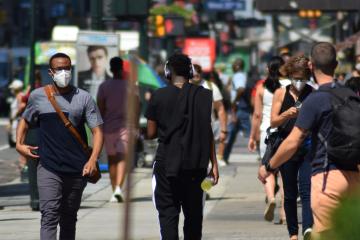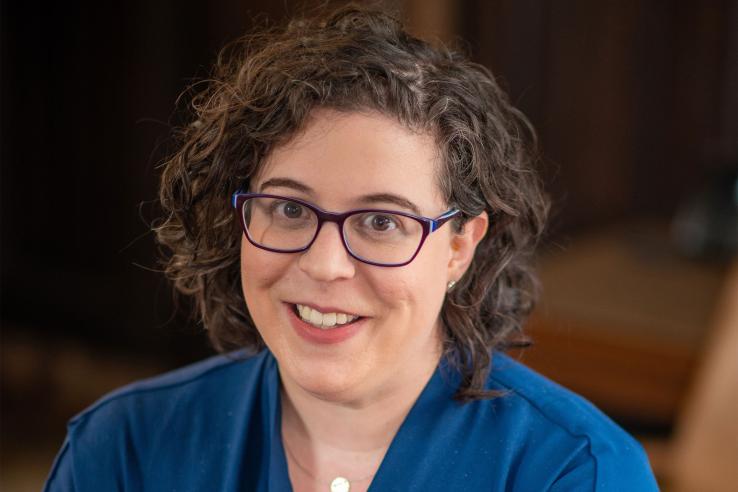
Affiliate Spotlight: Sarah Cohodes on remote education, school reopenings, and student learning during the COVID-19 pandemic

As the new school year begins and COVID-19 cases continue to spread across the United States, questions remain about how to educate students effectively and safely. We sat down with Sarah Cohodes––Associate Professor of Economics and Education at Teachers College, Columbia University––to discuss the school reopening process, the impact of remote learning on students and parents, and the potential paths forward. For more information on Professor Cohodes’ recommendations for reopening K-12 schools, read her column in The Atlantic.
Could you tell us a bit about the focus of your research and work before COVID-19? How has it changed since COVID-19?
My work focuses on policies that help students access high quality education. I can’t help but laugh when thinking about the beginning of the pandemic, when I was so overwhelmed with the enormity of school closures and lack of childcare, I thought that this had nothing to do with the issues I study. I now realize that COVID-19 is clearly connected to my research. What does access to high quality education mean when many typical modes of education are not safe? How do you promote access for the students who need it the most?
I think we're still in emergency mode and research questions are still developing, but I’m particularly interested in how families are adjusting to remote learning. The most important education work right now is probably understanding and describing the experiences of students, families, and teachers.
Can you speak a little bit about how your work and expertise as an education researcher has shaped your understanding of the challenges that schools are facing right now?
My work has shown me the impact that schools can have on students. So much of the “school reopening” conversation is about the risks and costs. We need to discuss the benefits of schools too, to understand how they can best serve students and families. COVID-19 is changing the conversation around the role schools play in society in terms of childcare and our social safety net.
We need to ask ourselves: Why have we been asking schools to play these roles? Is school the best place to do those things? We know that quality education can change the trajectory of young people's lives––we need to consider what must be done to maximize access to these opportunities.
As schools are grappling with reopening and exploring how, and to what extent, they can integrate technology, what lessons have emerged from evidence that can inform how these decisions are made?
We know technology interventions are not necessarily going to save anybody money or reduce the burden placed on teachers. I think there is incredible promise in technology to help us through this moment, but there's no getting around the fact that interaction with technology needs resource-rich investments in teachers to facilitate it.
We don't have the infrastructure for remote learning in large parts of the country. This goes beyond getting a student an iPad or setting up a WiFi hotspot. This moment is highlighting infrastructure that we should have been investing in over the past decade, including school building improvements, a reliable social safety net, and widespread internet access. While technology offers promise, more will need to be done to make that technology work. How can we help students to engage and interact with technology?
As schools face pressure to reopen and some are reopening, can you walk through the impacts that this will have on parents, students, and teachers?
There is, of course, the difficulty that schools as institutions are being asked to act alone, and a pandemic is not something that acts only in one sector. Just as we task schools with taking care of children's food needs and detecting abuse and neglect, we're now asking them to deal with a public health crisis.
It’s clear to me that the quickest path towards reopening school successfully is a nationwide virus suppression effort. In places with high community transmission, that would involve not reopening schools, as well as wider closures and lockdowns. Everywhere, we need more masking, testing, and contact tracing.
If we want schools to open as normal, we should prioritize schools over other activities. In order for those strategies to work, you have to pay people to stay home. All of this requires government action, which we are not seeing.
Regardless, schools are reopening. With social distancing requirements, they won’t be able to come back at full capacity. There are several models being suggested––some combine remote and in-person learning, some focus on young children for in-person instruction––but we also need to think about who needs support the most. Young children definitely need support, but so do students with special needs, English language learners, and students that are homeless or in foster care. The problem with all these plans is that there's no way for everybody to get everything.
As an economist, I think about face-to-face instruction as a resource that we can choose to allocate. I wish we were thinking about how we can allocate this precious resource in the way that it is going to have the most potential benefit with the least potential risk and cost.
A more thoughtful reopening would help to gain the trust of educators, ensuring that they are only being brought back to classrooms when the need is great, and that remote learning would be an option for the teachers and students that need it. A more thoughtful reopening would also give parents more certainty about their situations, which would facilitate work.
A number of other education tools, including tutoring, could also be considered scarce resources. What recommendations do you have for how we can target these resources to reach students who need them most? How can we use them to prevent widening of gaps by income level or racial group?
First off, we have made a choice to make tutoring a scarce resource. It doesn't have to be a scarce resource, as we could invest in ways to make tutoring a valued part of how we cope with and eventually recover from this time.
In my mind, the appropriate strategy to keep gaps from widening would be to make a tremendous effort to suppress the virus now, so that students can return to normal schooling as soon as possible. Then, schools can assess where students are, address their needs, and turn to options like tutoring, longer school days, summer school, vacation academies, credit recovery, or other strategies to help students catch up.
While we focus on virus suppression, we may need to relax our standards and expectations for the moment, especially for younger kids who have time to catch up. On the other hand, we’ve set up our school system in a way that if you struggle with reading by the end of second grade, it’s very hard to succeed.
I also worry a lot about high school students who may have been on the verge of dropping out before the pandemic, and other high school students who are now not returning to school because they are supporting younger siblings or working to help their family. Helping these students with targeted counseling to graduate high school is an imperative now.
Figuring out which children need support isn’t rocket science. If a teacher hasn’t been in touch with a child since March, they need support. If a student needed support in the classroom before schools closed, has special needs, is learning English, or doesn’t know how to read––they need support.
When students are back in school, there will need to be a time of assessment, followed by investment in additional supports for many years to come, if we want students to recover and be resilient. Right now, the biggest focus should be on connecting students with the school system who were not connected in the spring, especially given the high likelihood of remote schooling across the country.
What role do you think education researchers should play as the new school year begins?
We should not be doing any research that is putting additional burden on schools and students at this time, and I don't think that we should put adults in schools that don't need to be there. The question then becomes, what data can we gather and what research can we do in this context?
We know that the pandemic is detrimental to learning—you don't need research to tell you that. But research can inform our understanding of how it’s impacting different students. Looking at data that’s passively collected while students interact with learning tools can tell us about which students need the most help.
Research can also try to identify strategies that help students recover, but again, I don't think those questions are too complex. I think that things that have worked in the past will hopefully work again, even if we have to think about new formats and ways of doing it.
To me, the most important thing that can happen now is just keeping track of what is happening to students––who is going to school, how much school they're getting, and what type of school they're getting. This will help with targeting interventions––which will need to be ongoing for years.
Can you speak a bit about how reopening schools is going to affect parents?
Parents are struggling right now. Some of the families that this is going to affect the most are single parent families, because many single parents have found ways to make child care work within intergenerational family networks. The terrible thing about this particular disease is that by bringing grandma into your bubble, you're putting grandma at risk. If you’re relying on grandma to care for your child and you are an essential worker, there are extremely difficult choices to be made, and our society’s failure to invest in childcare, both before and during the pandemic, limits those options even more.
Something else to consider is how this will affect women. In heterosexual relationships, it is most often women picking up the slack in terms of home production and remote learning. This is also a structural issue since women are paid less than men, making them the partner that’s more likely to take a step back from the workforce if necessary. Once you leave the workforce and time goes by, it's much harder to re-enter the market.
For women who keep their jobs, there’s a worry that child care tasks will need to interrupt or take priority over work. In these instances, who is going to get promoted? Who is going to get a raise? Who is going to be seen as a leader? This is going to scar women's labor market prospects for years to come.
As a mother of a young child, you may have confronted many of the issues that you described. How has this motivated your research and your outlook on the overall educational crisis?
Even outside of the COVID-19 crisis, being a mom made my work both more and less important. It was less important because I had my family and wanted to spend time nurturing it and watching it grow. It also became more important because every single child who is a data point in my research is a child who has somebody who loves them and wants to watch them grow in that same way.
It was hard in April and May when it was just me and my daughter watching PBS Kids all day while I tried to work on emails and classes and my husband went to work as a health care provider. I’m lucky to have a spouse who has prioritized my career, which is rare for women. But this time, my husband’s work was clearly more important than mine, since he was doing COVID testing, and I was trying to run regressions in Stata. So there was no choice when it came to who would do childcare and who would focus on work. And for us, that happened to fall along the typical gender lines you see in the labor market.
We also have the resources to get through this tough time, and don’t have to worry about job loss or access to food. Of course, even in academia, there are structures in place that disadvantage moms and working parents, and I worry about my research slowing down. But I have resources to be resilient in this moment. So many families, and so many moms, are working with fewer resources and fewer options.
Any final thoughts?
My final thought is this: The best way to help kids learn is to get them back into something that looks closer to normal school. The best way to get kids into normal school is to suppress the virus, have an actual federal response, pay people to stay home where needed, and give schools the money they need to transform into safe and enriching spaces for students and teachers. Until those things happen, I don't think we're going to be able to move forward in a coordinated way that helps kids.
